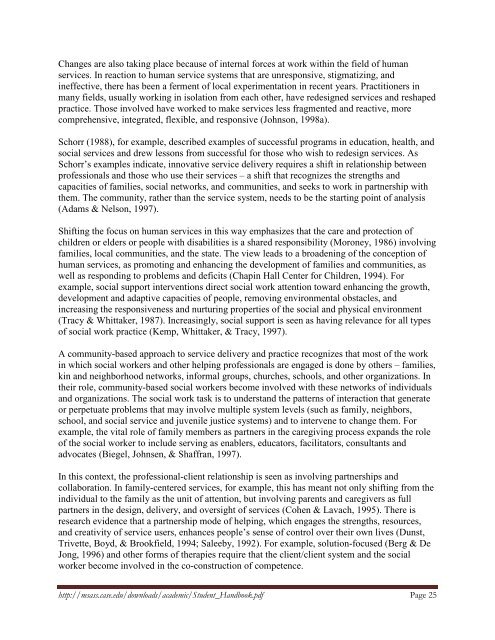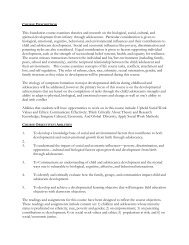Changes are also taking place because <strong>of</strong> internal forces at work within the field <strong>of</strong> humanservices. In reaction to human service systems that are unresponsive, stigmatizing, andineffective, there has been a ferment <strong>of</strong> local experimentation in recent years. Practitioners inmany fields, usually working in isolation from each other, have redesigned services and reshapedpractice. Those involved have worked to make services less fragmented and reactive, morecomprehensive, integrated, flexible, and responsive (Johnson, 1998a).Schorr (1988), for example, described examples <strong>of</strong> successful programs in education, health, andsocial services and drew lessons from successful for those who wish to redesign services. AsSchorr’s examples indicate, innovative service delivery requires a shift in relationship betweenpr<strong>of</strong>essionals and those who use their services – a shift that recognizes the strengths andcapacities <strong>of</strong> families, social networks, and communities, and seeks to work in partnership withthem. The community, rather than the service system, needs to be the starting point <strong>of</strong> analysis(Adams & Nelson, 1997).Shifting the focus on human services in this way emphasizes that the care and protection <strong>of</strong>children or elders or people with disabilities is a shared responsibility (Moroney, 1986) involvingfamilies, local communities, and the state. The view leads to a broadening <strong>of</strong> the conception <strong>of</strong>human services, as promoting and enhancing the development <strong>of</strong> families and communities, aswell as responding to problems and deficits (Chapin Hall Center for Children, 1994). Forexample, social support interventions direct social work attention toward enhancing the growth,development and adaptive capacities <strong>of</strong> people, removing environmental obstacles, andincreasing the responsiveness and nurturing properties <strong>of</strong> the social and physical environment(Tracy & Whittaker, 1987). Increasingly, social support is seen as having relevance for all types<strong>of</strong> social work practice (Kemp, Whittaker, & Tracy, 1997).A community-based approach to service delivery and practice recognizes that most <strong>of</strong> the workin which social workers and other helping pr<strong>of</strong>essionals are engaged is done by others – families,kin and neighborhood networks, informal groups, churches, schools, and other organizations. Intheir role, community-based social workers become involved with these networks <strong>of</strong> individualsand organizations. The social work task is to understand the patterns <strong>of</strong> interaction that generateor perpetuate problems that may involve multiple system levels (such as family, neighbors,school, and social service and juvenile justice systems) and to intervene to change them. Forexample, the vital role <strong>of</strong> family members as partners in the caregiving process expands the role<strong>of</strong> the social worker to include serving as enablers, educators, facilitators, consultants andadvocates (Biegel, Johnsen, & Shaffran, 1997).In this context, the pr<strong>of</strong>essional-client relationship is seen as involving partnerships andcollaboration. In family-centered services, for example, this has meant not only shifting from theindividual to the family as the unit <strong>of</strong> attention, but involving parents and caregivers as fullpartners in the design, delivery, and oversight <strong>of</strong> services (Cohen & Lavach, 1995). There isresearch evidence that a partnership mode <strong>of</strong> helping, which engages the strengths, resources,and creativity <strong>of</strong> service users, enhances people’s sense <strong>of</strong> control over their own lives (Dunst,Trivette, Boyd, & Brookfield, 1994; Saleeby, 1992). For example, solution-focused (Berg & DeJong, 1996) and other forms <strong>of</strong> therapies require that the client/client system and the socialworker become involved in the co-construction <strong>of</strong> competence.http://msass.case.edu/downloads/academic/<strong>Student</strong>_<strong>Handbook</strong>.pdf Page 25
Involving service users and other citizens in the design and delivery <strong>of</strong> services is fundamental todeveloping an integrated service system that is responsive to its neighborhood or communitycontext, culturally responsive, and empowering (Minkler, 1997). This approach discouragesdeficit-oriented and client-blaming discussion <strong>of</strong> families and their interactions with formalservice systems. It enables pr<strong>of</strong>essionals to see strengths and capacities in families andcommunities to which they may have been blind, and helps assure that services are driven by theneeds <strong>of</strong> families and communities rather than by funding or bureaucratic considerations.Importance <strong>of</strong> These Changes for <strong>Social</strong> Work and MSASSThese major policy and programmatic changes are reshaping the context <strong>of</strong> social work practice.This changing context <strong>of</strong> social work practice has implications for every aspect <strong>of</strong> the socialwork curriculum, including field instruction and field education (Jarman-Rohde, McFall, Kolar,& Strom, 1997). Preparing students for social work practice in the 21 st century requires newattention to community-based and innovative approaches for meeting the complex needs <strong>of</strong>individuals and families.New conceptualizations <strong>of</strong> community-based practices are being forged and refined throughdemonstration projects and community initiatives sponsored by major philanthropicorganizations (Edna McConnell Clark Foundation, 1998; Ford Foundation, 1998; W. K. KelloggFoundation, 1998) as well as local foundations. According to Kubish, Weiss, Schorr, & Connell(1995), comprehensive community initiatives …contain several or all <strong>of</strong> the following elements and aim to achieve synergy among them:expansion and improvement <strong>of</strong> social services and supports, such as child care, youthdevelopment, and family support; health care, including mental health care; economicdevelopment; housing rehabilitation and/or construction; community planning andorganizing; adult education; job training; school reform; and quality-<strong>of</strong>-life activities suchas neighborhood security and recreation programs (p.1).Naparstek and Dooley’s (1997) community building work identifies “people-based, place-based”strategies for working in geographically distinct, urban areas. This approach focuses on theassets and strengths <strong>of</strong> communities in combination with comprehensive and integratedneighborhood-based strategies that involve local residents. Other asset-based and communitybuilding approaches have been described (See, for example, Gittel & Avis, 1998; Jason, 1997;Kretzmann & McKnight, 1993; Sherraden & Page-Adams, 1997).In view <strong>of</strong> changes in the social work practice environment and the growing knowledge <strong>of</strong>innovative community-based approaches to social work practice, many schools <strong>of</strong> social workare engaging in curriculum development and revisions regarding the concept <strong>of</strong> communitybasedpractice. Overall, these changes indicate a revitalization <strong>of</strong> an historical commitment tocommunity social work on the part <strong>of</strong> some schools as well as new initiatives within manyschools that do not have a historical emphasis in community-based curriculum. Examples <strong>of</strong>curriculum change related to community-based practice range from new community practicecourses to new MSW curriculum, from combined concentration programs to interdisciplinarycertificates, from new practicum opportunities to community outreach programs developed andimplemented by schools <strong>of</strong> social work.http://msass.case.edu/downloads/academic/<strong>Student</strong>_<strong>Handbook</strong>.pdf Page 26
- Page 1 and 2: MSSAStudentand FacultyManual2012-20
- Page 3 and 4: TABLE OF CONTENTSWELCOME TO MSASS!
- Page 5 and 6: From the University ...............
- Page 7 and 8: CASE AND MSASS OVERVIEWCase Western
- Page 9 and 10: Convenient Facilities:Degree Progra
- Page 11 and 12: 2. Advocate for Social, Economic, a
- Page 13 and 14: Advanced LevelKnowledge:• Underst
- Page 15 and 16: Foundation LevelKnowledge:• Criti
- Page 17 and 18: Assessment:‣ Can ask relevant que
- Page 19 and 20: • Knows the requirements of infor
- Page 21 and 22: • Develops skills in engaging per
- Page 23 and 24: • Evaluates own practice effectiv
- Page 25: • Deals effectively with change i
- Page 29 and 30: PersonalCommunity(Davidson, 1986)pr
- Page 31 and 32: • Community-based practice social
- Page 33 and 34: Jarman-Rohde, L., McFall, J., Kolar
- Page 35 and 36: social workers are required to coop
- Page 37 and 38: Community and Social Development at
- Page 39 and 40: • Assessment issues, skills and t
- Page 41 and 42: PROGRAMS AND OPTIONS FOR STUDYTwo-Y
- Page 43 and 44: The Part-Time Program may be comple
- Page 45 and 46: For additional information, please
- Page 47 and 48: Mandel School of Applied Social Sci
- Page 49 and 50: For more information, visit the pro
- Page 51 and 52: miss more than one day; in the full
- Page 53 and 54: Friday (6 class contact hours)Morni
- Page 55 and 56: Emotional/Health/Medical Problems
- Page 57 and 58: The associate dean for academic aff
- Page 59 and 60: c) The academic team member may con
- Page 61 and 62: VII. Appeal1) The student may appea
- Page 63 and 64: writing, to the Associate Dean for
- Page 65 and 66: • Treating the person in a prefer
- Page 67 and 68: Testing dates are noted on the acad
- Page 69 and 70: SOCIAL WORK LICENSINGWhen MSASS stu
- Page 71 and 72: MSASS TUITIONNew students accepted
- Page 73 and 74: For additional information about th
- Page 75 and 76: Case Western Reserve University has
- Page 77 and 78:
Escort ServiceCase student escort s
- Page 79 and 80:
is disclosure to school officials w
- Page 81 and 82:
Data on retention and graduation ra
- Page 83 and 84:
The college years mark a time when
- Page 85 and 86:
Guidelines for Reserves1. Requests
- Page 87 and 88:
• Option to time release of quizz
- Page 89 and 90:
Computer LabThe MSASS Computer Lab
- Page 91 and 92:
Students must be in good academic s
- Page 93 and 94:
the form (it would be helpful to ke
- Page 95 and 96:
UNIVERSITY POLICIESALCOHOL USE AND
- Page 97 and 98:
There are certain circumstances whe
- Page 99 and 100:
• incest• sexual assault with a
- Page 101 and 102:
FINDING YOUR WAY…Academic Calenda
- Page 103 and 104:
OFFICES OF ACADEMIC AFFAIRS, STUDEN
- Page 105 and 106:
MANDEL SCHOOL ADMINISTRATIONGrover
- Page 107 and 108:
CURRICULUM “GO TO” PEOPLECONCEN
- Page 109 and 110:
http://msass.case.edu/downloads/aca
- Page 111 and 112:
Claudia J. Coulton, PhD(Case Wester
- Page 113 and 114:
Eva Kahana, PhD(University of Chica
- Page 115 and 116:
Diana Morris, PhD(Case Western Rese
- Page 117 and 118:
Zoe Breen Wood, MSW(Virginia Common
- Page 119 and 120:
College Station (216-791-1600) T-W:
- Page 121 and 122:
Marc’s Coventry (216-320-1000) M-
- Page 123 and 124:
Radisson Hotel at Gateway - Downtow
















